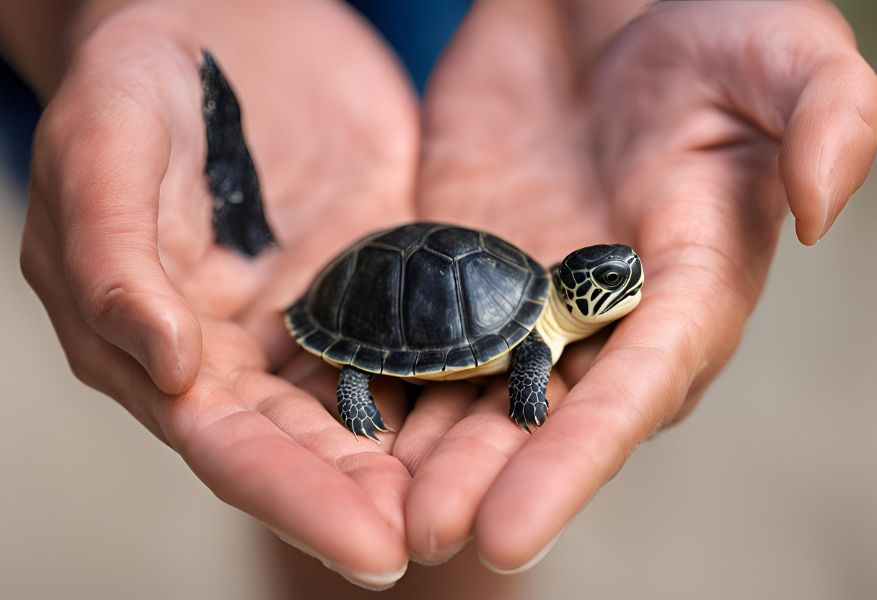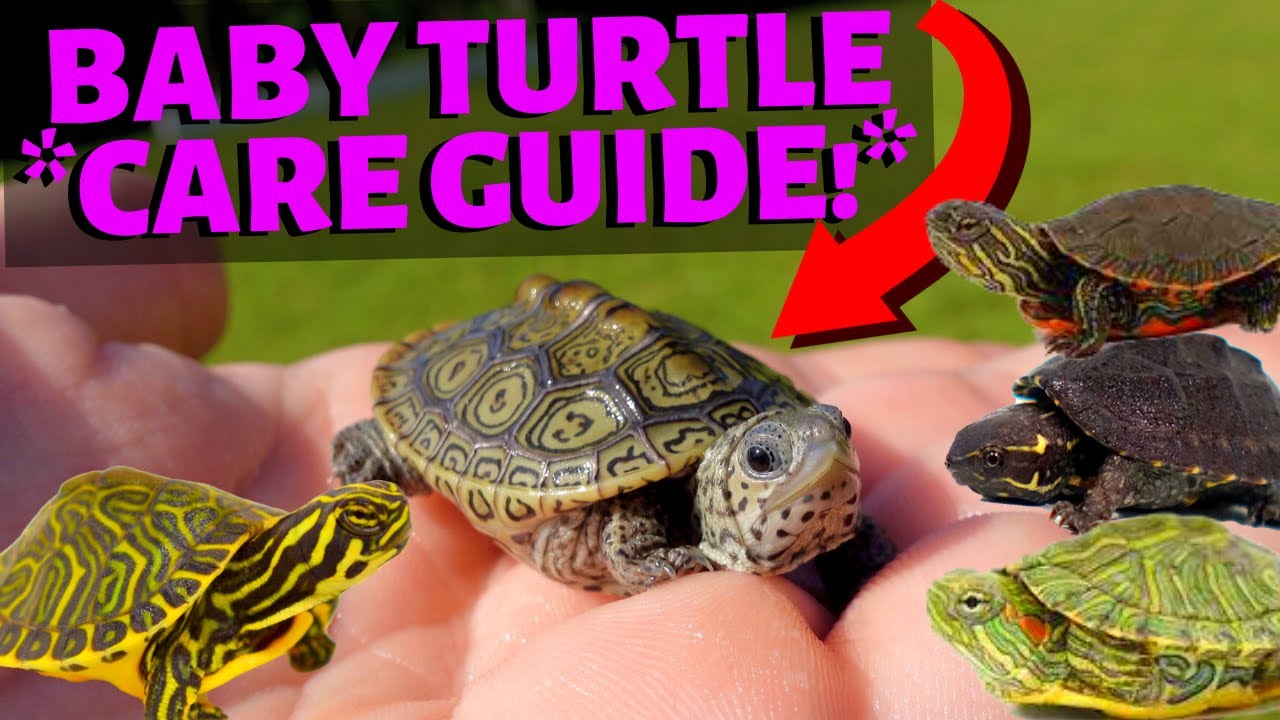To care for baby turtles, provide a clean habitat with proper UV lighting, heat, and a balanced diet. Ensure their environment mimics their natural habitat to promote their growth and well-being.
Baby turtles require specific care to thrive and stay healthy. By following these guidelines, you can help your baby turtle grow into a strong and happy adult. Taking proper care of your baby turtle is essential for their development and longevity.
Let’s explore some key tips and best practices for ensuring your baby turtle’s health and happiness.

Choosing The Right Habitat
Selecting The Tank Or Enclosure
When setting up a habitat for baby turtles, choosing the right tank or enclosure is crucial.
- Ensure the tank is spacious enough for the baby turtle to move around.
- Opt for a tank with a secure lid to prevent escape.
- Consider a glass tank or plastic container as suitable options.
Setting Up Proper Heating And Lighting
Proper heating and lighting are essential for the health and well-being of baby turtles.
- Install a heat lamp to maintain the ideal temperature in the habitat.
- Use a UVB light to provide the necessary ultraviolet rays for turtle growth.
- Place the heat lamp and UVB light at a safe distance from the turtle’s basking area.
Feeding And Nutrition
To properly care for baby turtles, it is essential to provide a balanced diet rich in protein, vitamins, and minerals. This can include commercial turtle pellets, live or frozen insects, and fresh leafy greens. It’s important to offer a variety of foods to ensure the turtles receive all the necessary nutrients for their growth and development.
Feeding baby turtles can be a little tricky, especially if you’re new to the world of turtle care. But with the right knowledge and tools, you can ensure that your little shelled friend is getting the nutrition they need to grow and thrive.
Understanding The Dietary Needs
Before we get into the specifics of feeding schedules and portions, it’s important to understand what baby turtles need in their diet. Most baby turtles are omnivores, which means they eat both meat and plants. Some common foods for baby turtles include:
- Commercial turtle food pellets
- Leafy greens like spinach, kale, and collard greens
- Fruits like berries, melons, and bananas
- Protein sources like mealworms, crickets, and small pieces of cooked chicken or fish
It’s important to note that different species of turtles may have slightly different dietary needs, so it’s always a good idea to do some research on the specific type of turtle you have.
Feeding Schedule And Portions
When it comes to feeding baby turtles, it’s important to establish a regular feeding schedule. Most baby turtles should be fed daily, although some species may only need to be fed every other day. It’s also important to keep an eye on how much your turtle is eating. A good rule of thumb is to feed your turtle an amount of food that’s roughly the size of their head.
Here’s an example feeding schedule for a baby turtle:
| Time of Day | Food |
|---|---|
| Morning | 2-3 commercial turtle food pellets |
| Afternoon | A small amount of leafy greens |
| Evening | A small amount of protein (mealworms, crickets, or cooked chicken or fish) |
Remember, every turtle is different, so it’s important to keep an eye on your pet’s appetite and adjust their feeding schedule and portions as needed.
Feeding and nutrition are essential components of baby turtle care. By understanding your turtle’s dietary needs and establishing a regular feeding schedule, you can help ensure that your little shelled friend is getting the nutrition they need to grow and thrive.
Handling And Interaction
When it comes to caring for baby turtles, handling and interaction are crucial aspects that require careful attention. Proper handling techniques and positive interaction can help build trust and ensure the well-being of your pet turtle. In this section, we will explore the best practices for handling and interacting with baby turtles to promote their health and happiness.
Creating A Safe Handling Environment
Creating a safe environment for handling baby turtles is essential to minimize stress and ensure their safety. Before handling a baby turtle, it’s important to wash your hands thoroughly to remove any potential contaminants that could harm the turtle. Additionally, always handle the turtle over a soft surface, such as a towel or a cushion, to prevent injuries from accidental falls. Avoid sudden movements and loud noises, as these can startle the turtle and cause unnecessary stress.
Building Trust Through Interaction
Interaction plays a vital role in building trust between you and your baby turtle. Start by allowing the turtle to acclimate to its new environment before attempting any interactions. Spend time near the turtle’s enclosure, talking softly and moving slowly to help the turtle feel comfortable in your presence. Offering food by hand can help the turtle associate you with positive experiences, gradually building trust over time. It’s important to be patient and gentle, allowing the turtle to approach you at its own pace.

Health And Wellness
Baby turtles, like all living creatures, require proper care and attention to maintain their health and wellness. By understanding how to recognize signs of illness and scheduling regular health check-ups, you can ensure that your baby turtle leads a happy and healthy life.
Recognizing Signs Of Illness
It’s important to be vigilant and keep an eye out for any signs of illness in your baby turtle. Some common indications of illness include:
- Lethargy and lack of activity
- Loss of appetite
- Abnormal swelling or lumps
- Cloudy or swollen eyes
- Irregular breathing or wheezing
Regular Health Check-ups
Regular health check-ups are crucial for ensuring the well-being of your baby turtle. Schedule appointments with a reptile veterinarian who can perform thorough examinations and provide necessary vaccinations. During these check-ups, the veterinarian will assess the turtle’s overall health, check for any signs of illness, and provide guidance on proper nutrition and habitat maintenance.
Environmental Enrichment
Enhance baby turtles’ well-being by providing environmental enrichment in their habitat. Incorporate hiding spots, basking areas, and varied textures to stimulate natural behaviors and promote their overall health. This practice encourages active engagement and reduces stress, ensuring a thriving environment for baby turtles.
Environmental enrichment is crucial for the well-being of baby turtles as it helps to simulate their natural habitat and provides mental and physical stimulation. Creating a stimulating habitat and providing opportunities for exercise are essential aspects of environmental enrichment for baby turtles.
Creating A Stimulating Habitat
Creating a stimulating habitat for baby turtles involves replicating their natural environment as closely as possible. This can be achieved by incorporating natural elements such as rocks, plants, and driftwood into their enclosure. These elements provide hiding spots, climbing opportunities, and exploration, which are essential for the turtles’ mental and physical well-being.
Providing Opportunities For Exercise
Opportunities for exercise are vital for the development and health of baby turtles. Incorporating a variety of surfaces such as sand, gravel, and smooth rocks in their habitat encourages the turtles to move around and explore different textures. Additionally, providing a shallow water area allows the turtles to swim and exercise their muscles, promoting overall health and well-being.
By focusing on environmental enrichment, baby turtles can thrive in captivity and lead healthy, fulfilling lives.

Growth And Development
As baby turtles grow, it’s essential to monitor their development and provide the necessary support for their healthy growth. Understanding the growth and development milestones of baby turtles is crucial in ensuring their well-being and longevity.
Monitoring Growth Milestones
It’s important to keep track of the growth milestones of baby turtles to ensure they are developing at a healthy pace. This includes monitoring their size, weight, and shell development. Regularly measuring and recording these milestones can help identify any potential issues early on.
Supporting Healthy Development
Supporting the healthy development of baby turtles involves creating the right environment and providing proper nutrition. Ensuring they have access to clean water, a basking area, and appropriate lighting is crucial. Additionally, offering a well-balanced diet that includes a variety of live and commercial foods is essential for their growth and development.
Socialization And Bonding
Discover the significance of socialization and bonding in baby turtle care. Building strong relationships with these tiny reptiles is essential for their overall well-being and development. Create a nurturing environment that encourages interaction and companionship to ensure your baby turtles thrive.
Encouraging Social Interaction
Baby turtles are social creatures and need to interact with other turtles to develop properly. Encouraging social interaction is crucial to their growth and well-being. You can do this by providing a spacious tank or enclosure where your baby turtle can move around freely and interact with other turtles.
Make sure you provide plenty of hiding spots, basking areas, and plants for your baby turtle to explore. It is also important to keep the water clean and at the right temperature, as this will ensure your baby turtle remains healthy and active.
Building A Strong Bond
Bonding with your baby turtle is essential for their emotional and physical development. You can do this by providing them with a comfortable and secure habitat, feeding them on a regular basis, and spending time with them every day.
You can also hold your baby turtle gently and stroke their shell, which can help them feel more comfortable and secure in your presence. As your baby turtle grows, you can also introduce toys and other interactive activities to help them develop their motor and cognitive skills.
Conclusion
Caring for baby turtles requires time, patience, and dedication. By encouraging social interaction and building a strong bond with your baby turtle, you can help them develop into healthy and happy adults. Remember to always provide them with a comfortable and secure habitat, nutritious food, and plenty of love and attention.
Preparing For The Future
When caring for baby turtles, it’s crucial to plan ahead for their long-term needs. By understanding the care requirements as they grow, you can ensure a healthy and happy future for your shelled friend.
Understanding Long-term Care Needs
Baby turtles will eventually grow into adults, so it’s essential to anticipate their changing needs. As they mature, their diet, tank size, and environmental requirements will evolve. Regular research and monitoring are key to providing the best care.
Planning For Adulthood
Invest in a larger tank as your turtle grows to provide ample space for swimming and basking. Consider upgrading the filtration system to accommodate the increased waste production. Consult with a reptile specialist for guidance on transitioning to an adult turtle care routine.

Conclusion
In caring for baby turtles, remember to provide proper housing, diet, and environment. Regular health checks and monitoring are essential. With patience and attention to detail, you can ensure your baby turtles thrive and lead a healthy life. Remember, their well-being is in your hands.






Leave a Reply